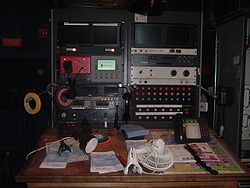
Prompt corner
Encyclopedia

Theatre
Theatre is a collaborative form of fine art that uses live performers to present the experience of a real or imagined event before a live audience in a specific place. The performers may communicate this experience to the audience through combinations of gesture, speech, song, music or dance...
is the location at the side of the stage
Stage (theatre)
In theatre or performance arts, the stage is a designated space for the performance productions. The stage serves as a space for actors or performers and a focal point for the members of the audience...
where the prompt
Prompt (theatre)
The prompt in a theatre is traditionally the person who prompts or cues actors when they forget their lines or neglect to move on the stage to where they are supposed to be situated....
(usually the Stage Manager
Stage management
Stage management is the practice of organizing and coordinating a theatrical production. It encompasses a variety of activities, including organizing the production and coordinating communications between various personnel...
in US or Deputy Stage Manager
Stage management
Stage management is the practice of organizing and coordinating a theatrical production. It encompasses a variety of activities, including organizing the production and coordinating communications between various personnel...
in the UK) is located in order to coordinate the performance and prompt the performers when required.
Location
Historically, the prompt corner was situated on the (performer's) left side of the stage, therefore Prompt Side (abbreviated to P or PS) and Opposite Prompt (OP) (occasionally called "Off Prompt") are widely used terms for stage left and stage right when blockingBlocking (stage)
Blocking is a theatre term which refers to the precise movement and positioning of actors on a stage in order to facilitate the performance of a play, ballet, film or opera. The term derives from the practice of 19th century theatre directors such as Sir W. S...
a performance.
In some theatres, the prompt desk is situated on stage right, known as a bastard prompt. In this case stage right and left are known as Bastard Side (BS) and Opposite Bastard (OB). This can cause some confusion for actor
Actor
An actor is a person who acts in a dramatic production and who works in film, television, theatre, or radio in that capacity...
s in touring shows, when the prompt desk is perceived to be on the 'wrong' side of the stage.
The prompt desk
The prompt corner is usually equipped with a prompt desk to facilitate the coordination of a performance. It can vary from a small table in the wings, to a complete installation in a separated booth. The prompt desk has space for a copy of the scriptManuscript
A manuscript or handwrite is written information that has been manually created by someone or some people, such as a hand-written letter, as opposed to being printed or reproduced some other way...
, and can also include some, all or none of the following features:
- Communications intercomIntercomAn intercom , talkback or doorphone is a stand-alone voice communications system for use within a building or small collection of buildings, functioning independently of the public telephone network. Intercoms are generally mounted permanently in buildings and vehicles...
headsetHeadphonesHeadphones are a pair of small loudspeakers, or less commonly a single speaker, held close to a user's ears and connected to a signal source such as an audio amplifier, radio, CD player or portable Media Player. They are also known as stereophones, headsets or, colloquially, cans. The in-ear...
, or cans, to talk to the rest of the technical team during a show. - Red and Green cue lights, to assist with giving cues. In some theatres a computerised cue light system is used.
- TelephoneTelephoneThe telephone , colloquially referred to as a phone, is a telecommunications device that transmits and receives sounds, usually the human voice. Telephones are a point-to-point communication system whose most basic function is to allow two people separated by large distances to talk to each other...
communications to Front of House areas. - Public addressPublic addressA public address system is an electronic amplification system with a mixer, amplifier and loudspeakers, used to reinforce a sound source, e.g., a person giving a speech, a DJ playing prerecorded music, and distributing the sound throughout a venue or building.Simple PA systems are often used in...
system to the rest of the theatre so the stage manager, deputy stage manager (normally the person calling the show) can make announcements or give calls to the foyer ('front of house'), auditorium ('house'), dressing rooms or other 'back of house' area in the theatre. - A silent fire alarm indicator, such as a strobe lightStrobe lightA strobe light or stroboscopic lamp, commonly called a strobe, is a device used to produce regular flashes of light. It is one of a number of devices that can be used as a stroboscope...
. - Controls for the safety curtainSafety curtainA safety curtain is a fire safety precaution used in large proscenium theatres. It is usually a heavy fibreglass or iron curtain located immediately behind the proscenium arch. Asbestos-based materials were originally used to manufacture the curtain, before the dangers of asbestos were discovered...
or other emergency measures.

